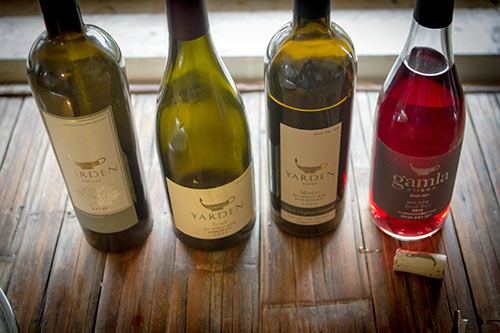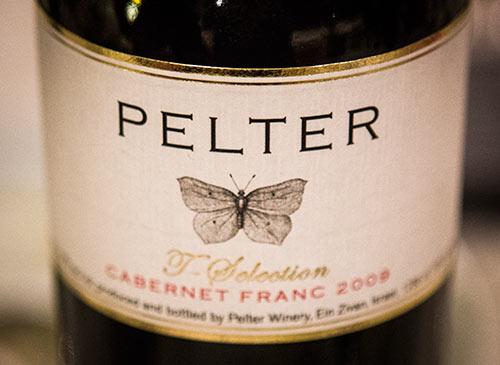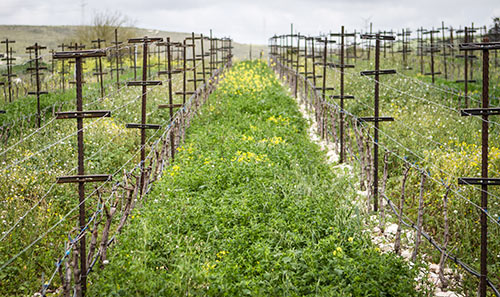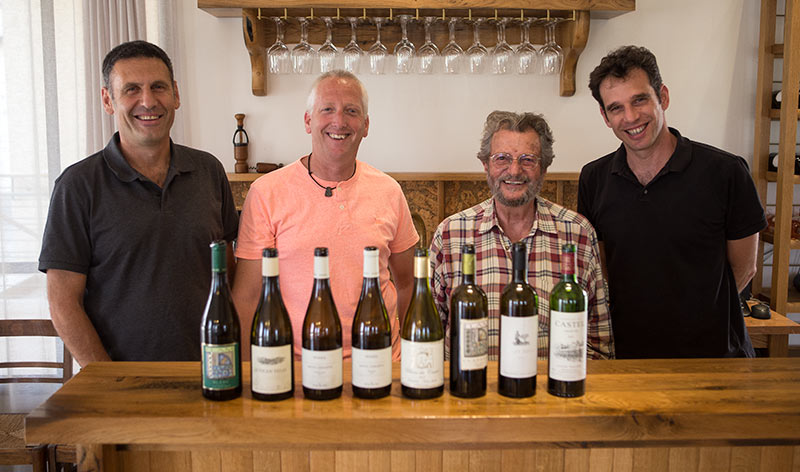
The general perception of Israel in most people’s mind is how it looks in the Negev Desert, but the reality is that a good deal more of it looks like the northern reaches of Galilee with lush, green valleys and hills awash in every square centimeter that’s cultivable growing something. To anyone that I’ve talked about the trip to since returning, they generally ask about the security, especially up in this northern area. It’s a reasonable question for anyone who reads the news and hears about the ongoing conflict of Syria which this part of Israel shares a northern border with. But again, the reality is that it’s very safe, has been for decades, and Israel spends untold amounts of money to ensure that it stays as such. If you think about it, wine vines, that take a minimum of three years to reach production maturity are grown up there and you don’t do that in a region prone to warfare.
That said there is the sticky issue of Golan that should be mentioned. Israel, as of 1981 officially claims this region as theirs and while not recognized by the UN, it seems to be de facto Israeli at this point. In showing how it appears on Google Maps to Israelis that squinted up their faces and said, “What the hell is that?” And it’s true, with essentially four dotted lines making up two DMZs, it’s really weird looking. I have no interest in addresses the political ramifications of this region, but it’s here where what seemed to be the most elegant grapes from the country are sourced and it’s where we headed in between visits to the middle of Israel.

Before getting in to the wines though, it’s worth noting that we were treated to a lunch at the house of Erez Komarovsky. A renown chef in Israel, his home is in Upper Galilee where he cooks for people in communal meals. The lunch he served was essentially his life’s experience on display with herbs and ingredients from his garden mixed with decades of cooking around the world and opening bakeries and a restaurant in Israel. That, was a truly unadulterated pleasure.

Golan Heights Winery
While hosted by Erez, we talked with the winemakers and tasted the wines of Golan Heights Winery. There are many important points to note during the recent history of Israeli wines and 1983 was one of them as that’s when this winery was founded. They are truly in the core of Golan Heights with 96% of their vines up there, growing at altitudes ranging from 400-1200m which brings the much needed hot days and cool nights during the maturation period of the grapes. While we weren’t able to visit the vineyards due to time, apparently the soil is very volcanic basalt with good drainage. From the 600 hectares (yeah, 600!) of vineyards they cultivate, they produce some six million bottles of wine making them one of the biggest wineries in Israel.
As a special treat, they opened a bottle of their 2000 Blanc de Blancs sparkling. Despite 14 years of aging, it still showed wonderfully well with elegant, delicate fruit and touches of lime to the nose. In my notes I wrote that it was fresh and electric as I feel that it defined the wine very well. The 2013 Yarden Sauvignon Blanc was fresh with lemongrass notes. The Gamla Nature Syrah Rosé I was rather neutral about as I’m a difficult one with Rosé. But the Yarden 2008 Merlot was definitely noteworthy. With dark fruits and herbaceous, peppery watercress notes to the nose, it led in to a fresh body with surprisingly large tannins and a dry finish. Overall, I felt this wine defined their vineyards more than anything else and left me wanting to taste even more, but it was time to move on.

Pelter
We spent a night up in the north at a hotel spa called, Mizpe Hayamim which throughout the trip I could never get the name right. Thankfully it seemed to be well known as everyone was always able to correct me afterwards once I said the first name. A rather eccentric place, they’ve gone to great lengths to create a fully organic garden around the place which provides them with a very stellar spread for all their meals. It was during our dinner there that we were introduced to the wines of Pelter.
After working in Australia for some time and returning to Israel in 2001, Tal Pelter started producing a bit of wine on the side, starting with 4,000 bottles in 2002 which then grew in to a full-fledged business in 2005. They source half their grapes from Golan Heights with the other half being a mix of Galilee and Judean Hills grapes. In 2013, they produced 120,000 bottles, coming a very long way in a very short time with a new fully Kosher line coming as well.
The tasting of the wines passed rather quickly and it was a tough go after covering so much distance during the day. But, the general theme, which is what Tal emphasizes is to have easy to drink wines that pair well with meals. The Sauvignon Blanc, Gewurztraminer, Chardonnay, and Semillon all fit this bill. The Semillon I found a touch more noteworthy in the finish, but overall they were fine for meals and reasonably expressive. The Pinot Noir was the first we had tasty on the trip and was a curious creation with dark cherries to the nose and a bit of tar on the palate, but the fruit stood up overall. While the cellar process might need a bit more fine tuning (this is a tricky ass grape to tame in new regions) it has potential. The Cabernet Franc was quite expressive in the mouth with a clean finish and was the bottle I enjoyed the most overall. Tal’s dedication shows that he’s one to watch and see where he heads over the next 3-5 years.

Tulip
The next day we got up, chowed down on the very fantastic spread at the hotel and turned southward, making our next stop, Tulip. Located in Kfar Tikva (which means, “Village of Hope”) they work with the local community there who are people with special needs or disabilities. It’s similar to a winery near where I live and it’s an initiative that I can’t help but support as it blends civic well being with wine.
The winery’s history is similar to others in the “boutique” movement in that they started in 2003 being founded by the Yitzhaki family. Year after year they’ve grown with the straightforward goal of producing great, approachable wine. This is easy to see in their line of whites which are indeed that. Generally crisp and light in the body the White Tulip and Cabernet Franc Blanc follow this pattern and don’t offer up a lot of fruit on the palate. Probably good for Israel’s summer, but I wanted to find a bit more.
The Just Merlot 2012 offered that up. A blend of olive tapenade and light smoky notes in the nose, it also presented touches of cumin in the body with good tannins that lingered in to the finish. The Just Cabernet Sauvignon 2012 had a lot of dark fruits in the nose, but I found the body overtly green and vegetal. Mostly Shiraz 2012 both benefited and suffered from its aging regiment. With very nice red fruits to the nose with vanilla touches, the body was soft and velvety, but it felt overly boosted and came up a bit short in the finish.
Their Black Tulip, DNA, Espero, and Mostly Cabernet Franc were all appealing in their own way, but the Syrah Reserve 2010 spoke to me the most out of the group of their higher end wines. The nose is chocked full of dark plum notes and the body is flush with a perfume quality to it that gave a great deal of life to the wine and made it quite singular in my opinion with great balance and an elegant finish.

Bat Shlomo
While Bat Shlomo is sorta technically not Galilee, it sorta technically is, especially as regional wine maps in Israel are a bit “fluid” and will often lump the Carmel Mountains in to Greater Galilee. But it’s more the fact that I feel the level of quality and the trajectory of the wines is such that it is better lumped in to this northern group than any other. Sitting on the lands of the 19th century moshava (moshav? I’m still learning…) of Bat Shlomo, they lie just a bit south of the Carmel Mountains. The vines are all relatively new and beyond creating a new high quality, Kosher winery, there’s a reason that Elie Wurtman planted them there.
As the history goes, here is where Baron Edmond de Rothschild founded this Israeli settler establishment some 125 years ago and being a Frenchman who owned Lafite Rothschild in Bordeaux, he wanted to plant vines there as well. Those original vines were unfortunately long since torn up and replaced with various fruit trees. So, Elie’s plan is to slowly build up new vineyards, build a cellar in the moshava and create a living museum akin to Colonial Williamsburg in the US. A determined fellow, Elie will undoubtedly succeed in doing this.
In the meantime he’s hired Ari Erle to head up the enology and viticulture. Having studied at UC Davis and worked in Napa, he’s a sharp fellow and is doing wonderful things with the wines. The Sauvignon Blanc 2013 was one of the best that I tasted. Very well made with nice acidity and touches of green apple and white pear to the nose. The body was fresh, a touch tart, and nice and clean in to the finish.
The Chardonnay 2012 was something special. While it’s currently being produced from grapes that they buy, Ari has created a wonderfully elegant and restrained wine with wonderful mineral notes to the nose. The body is perfectly balanced with a clean, fresh finish and was one of my favorite wines from the trip–this is coming from someone incredibly tired with New World Chardonnay.
The Betty’s Cuvee 2012 they opened for us is 85% Cabernet Sauvignon with the rest being Petit Verdot and Cabernet Franc. It’s a wine that’s soon to be released and it was readily easy to see that it’d be happy to sit in the bottle for two or three years more. But it expressed a great, earthy body with touches of dried fig and truffle. Again, excellent balance with good, well massaged tannins and a dry, fresh finish.
Whatever Bat Shlomo is doing, I heavily encourage them to keep doing it and I look forward to tasting what will start to emerge from their own vineyards starting with the coming vintage.
And lastly, some closing thoughts about Israeli wine in general.

well written article and I agree with most of the assessments of the wines especially the Tulip Syrah Reserve which is very special.
Tulip will be spinning off a new boutique line as they believe Tulip approaching 200,000 bottles is getting too big to embrace Boutique moniker
Two corrections-
Pelter is NOT kosher but they are starting to make kosher wines which will appear under a different name/label (to avoid confusion) expect them later this year
Bat Shlomo definitely is not in the Galilee but the Carmelim region closer to Zichron Ya’acov area but on the southern edge of the Lower Galilee but are even part of a 22 local winery festival for the Carmelim region April 9th and 10th…yes the wine map/appellations for Israel are a bit fuzzy and I look forward to the day its clearer…they have official maps in the works but inside politics is delaying its release…I have one copy of said map
Thanks for the correction. Kosher is a really strange beast to me as scientifically it has no bearing, but I do understand the tradition just not all the little subtleties of it yet.
The issue of what is Galilee seems to be the bigger point and if the Carmel mountains are to be included in a larger Galilee region that includes the subregions of Carmel, Upper, Lower, and Golan.
If you can send me a copy of this map, I’d be very curious to see what they’re coming up with.